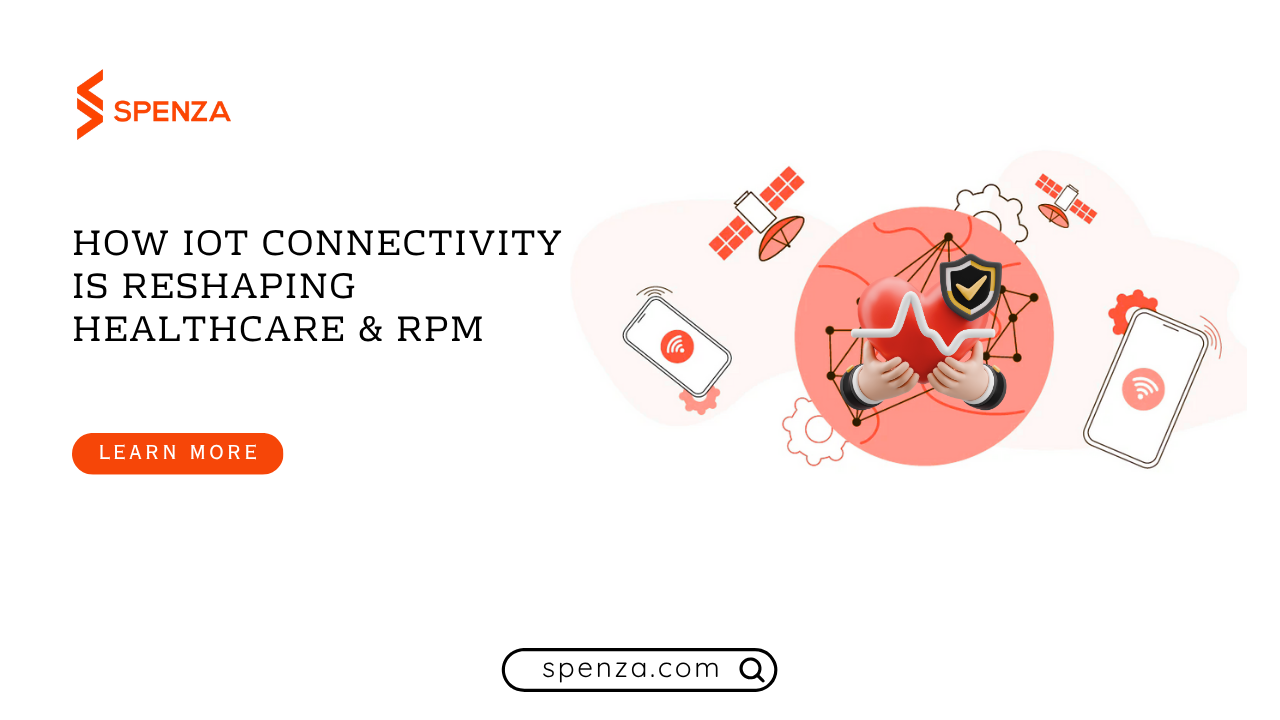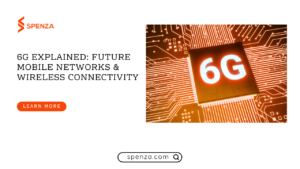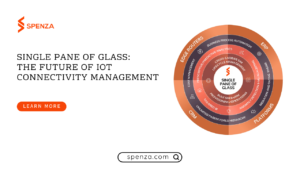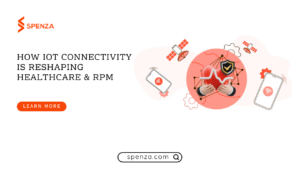TL;DR / At-a-Glance Summary
The New Pulse of Healthcare
IoT connectivity in healthcare connects patients, clinicians, and devices in real time, making care proactive instead of reactive.
Remote Monitoring Comes of Age
Remote patient monitoring connectivity turns wearables and home devices into clinical data sources, improving access, comfort, and treatment accuracy.
Predictive Care with Smart Networks
IoT in healthcare now works with AI and ML to spot health risks early, empowering faster, personalized care interventions.
Security Defines the Future
Secure healthcare IoT networks ensure every heartbeat, reading, and alert travels safely across regulated channels.
Spenza’s Top-Grade Connectivity
Spenza brings compliant medical device connectivity built for reliability, encryption, and global scale, made for healthcare’s toughest demands.
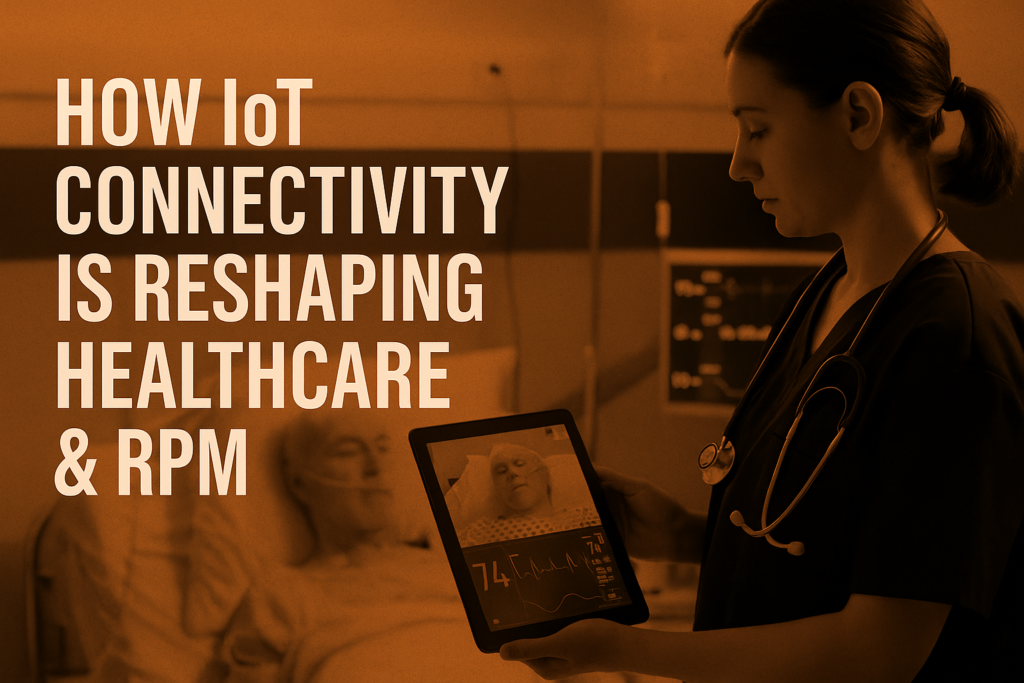
The integration of Internet of Things (IoT) connectivity into healthcare creates powerful connected ecosystems that link patients, medical devices, and care providers in real time. By enabling secure, compliant data exchange across these touchpoints, IoT transforms how care is delivered — shifting from reactive approaches to proactive, personalized, and cost-effective models. IoT connectivity empowers healthcare systems worldwide to achieve better outcomes, enhance patient experiences, and operate more sustainably.
The New Pulse of Healthcare: Why IoT Connectivity Matters
What happens when every patient, doctor, and device stays connected, all the time? The answer defines the future of healthcare. The global IoT in healthcare market is projected to soar from $56.7 billion in 2024 to $594.5 billion by 2035, growing nearly tenfold in just a decade. This surge proves one thing, IoT connectivity in healthcare has become the backbone of modern medicine.
It links heart monitors, glucose sensors, imaging systems, and telehealth platforms into one intelligent network. Remote patient monitoring connectivity lets clinicians see patients’ real-time vitals even when they’re miles away. These connections make medicine faster, more predictive, and safer.
In this blog, we’ll explore why IoT connectivity in healthcare is reshaping care delivery, why standard networks fail to meet clinical needs, and why platforms like Spenza’s IoT connectivity management platform deliver the reliability, security, and compliance healthcare demands.
How IoT Connectivity Is Transforming Care
Healthcare faces new realities, chronic disease, aging populations, and cost pressure. IoT connectivity in healthcare steps in to solve these challenges by moving care beyond hospital walls. Every device now becomes a source of insight.
The numbers are striking. Around 60% of hospitals globally already use IoT-connected medical systems, and this rose to nearly 87% by 2025. The global remote patient monitoring market, worth about $50 billion in 2024, is forecasted to exceed $200 billion by 2032, showing that RPM is not a trend, it’s the new normal.
Why now?
- Healthcare costs keep rising.
- Chronic illness requires daily monitoring, not quarterly visits.
- Patients want control over their data and care.
- Providers need real-time data to make faster, more accurate decisions.
IoT in healthcare fills that gap. Continuous, connected data changes outcomes. For instance, heart failure patients using RPM saw 45% fewer readmissions, and hospitals using connected solutions cut operating costs by about 26%. Each connected sensor becomes part of an ecosystem that supports smarter, preventive care.
As these networks grow, platforms like Spenza’s IoT connectivity in healthcare ensure these critical connections stay stable, compliant, and secure across multiple carriers and countries, a key difference from generic IoT networks.
Understanding the “why” sets the stage for the “how.” Let’s see how IoT connectivity and remote monitoring systems actually function behind the scenes.
How IoT Connectivity + RPM Works
At the core of remote patient monitoring connectivity are three layers: devices, data, and networks. Each must function flawlessly for continuous care.

- Devices: Sensors like glucose monitors, ECG patches, and blood pressure cuffs capture vitals.
- Data Flow: IoT connectivity in healthcare transmits this information securely to hospital systems or cloud platforms.
- Analytics: Clinicians analyze these live data streams using dashboards and AI tools.
Every heartbeat, blood sugar level, or oxygen reading travels through a secure network. This process sounds simple, but it depends on uninterrupted, compliant medical device connectivity. Traditional networks, like basic Wi-Fi or a single-carrier SIM, can’t guarantee the reliability healthcare demands. A single network outage could mean missed alerts or delayed care.
Reliable connectivity turns reactive care into predictive care. For example, hospitals using remote patient monitoring connectivity reduce emergency readmissions by up to 76%, while physicians report faster interventions and happier patients. IoT in healthcare also bridges distance, enabling rural patients to receive care equal to those in major cities.
Every patient-generated data point is a decision waiting to happen. The faster it reaches the clinician, the faster care turns into prevention.
How the Connectivity Ecosystem Functions
IoT connectivity in healthcare works through a precise chain that links patients, devices, and data systems. Each heartbeat, reading, or alert travels securely across this network in seconds. Every layer, from sensor to cloud, must stay reliable, encrypted, and compliant.
The table below shows how each layer functions together to keep clinical data flowing without interruption.
| Layer | Purpose | Clinical Requirement |
|---|---|---|
| Devices & Sensors | Collect vitals (heart rate, glucose, BP, oxygen) | Accuracy, low latency, medical certification |
| IoT Connectivity in Healthcare Networks | Transmit data to cloud or hospital systems | Uptime > 99.9%, encryption, redundancy |
| Cloud/Edge Systems | Store, process, and analyze data | HIPAA/GDPR compliance, integrity |
| Healthcare Applications | Display data to clinicians | Real-time alerts, integration with EHR |
| Analytics Layer (AI/ML) | Predict and prevent health issues | Fast computation, secure data flow |
Each layer relies on strong, secure healthcare IoT. Without it, data may lag or vanish. That’s why multi-carrier support, eSIM provisioning, and unified control, as provided by Spenza’s IoT eSIM in healthcare, are now becoming standard for global deployments.
Once data moves freely and securely, the benefits multiply. Let’s look at the tangible outcomes healthcare systems are already seeing.
Key Benefits of IoT Connectivity in Healthcare
The rewards are massive. Connected devices and remote patient monitoring connectivity deliver measurable improvements for both patients and providers.

1. Real-Time Monitoring Saves Lives
Clinicians no longer rely on patient memory or delayed reports. Continuous vitals give instant insight. A sudden oxygen drop triggers alerts immediately, enabling quick responses.
2. Cost Efficiency Across Systems
Hospitals report up to 26% lower operational costs through IoT automation. RPM programs save roughly $1,000 per patient annually, cutting emergency visits and hospital stays.
3. Fewer Readmissions, Better Outcomes
Remote patient monitoring connectivity reduces hospital readmissions by up to 76%, especially in chronic care. Real-time tracking ensures no anomaly goes unnoticed.
4. Data-Driven Decisions
IoT in healthcare systems analyze patient trends, predict health deterioration, and support treatment optimization, boosting accuracy and lowering risks.
5. Better Access & Comfort
Patients manage their conditions from home using mHealth solutions. It’s care without distance, more comfort, less stress, better adherence.
All these benefits depend on network integrity. Standard IoT fails under healthcare demands. The difference lies in clinical-grade reliability, uninterrupted uptime, secured transmission, and verified compliance.
That’s why platforms built for healthcare, such as Spenza’s device connectivity for medical IoT, are essential. These benefits prove why connected care works. Yet, adoption brings new technical and operational challenges that IT leaders must overcome.
Generic IoT networks drop signals. In healthcare, a dropped signal can drop trust. That’s why connectivity must be clinical-grade, not consumer-grade.
Challenges & Barriers Still Slowing Progress
Even as IoT connectivity in healthcare expands, challenges persist. The main hurdles come from three critical areas, reliability, security, and compliance.
1. Network Downtime Risks
A one-minute downtime in a connected ICU can cause critical data loss. Basic networks fail when they face coverage gaps or single-carrier dependency. Experts estimate that traditional IoT networks cause intermittent data loss in medical transmissions, risking incomplete records.
2. Security Concerns
Healthcare data breaches surged past 88 million compromised records. Each connected device increases risk. Secure healthcare IoT must encrypt every byte, protect endpoints, and isolate sensitive medical traffic.
3. Compliance Pressure
Every connected medical device must meet HIPAA and GDPR standards. With 10–15 devices per hospital bed now connected, compliance oversight becomes complex. Noncompliance can lead to fines or data exposure, eroding patient trust.
4. Integration Issues
Many IoT systems don’t integrate smoothly with Electronic Health Records (EHRs). Data silos slow care. Compliant medical device connectivity platforms must bridge these systems seamlessly.
5. Cost & Complexity
Implementing multi-network IoT in healthcare often involves multiple vendors, carrier contracts, and monitoring tools. Simplified, unified platforms like Spenza remove these obstacles through global eSIMs and single dashboards, cutting cost and confusion.
These issues reveal why standard IoT connectivity simply isn’t enough for medical systems. Healthcare needs a clinical-grade backbone built for life-critical reliability and absolute trust.
Once healthcare overcomes these hurdles, the next step is expansion, scaling connectivity through AI, automation, and predictive intelligence.
Future Outlook: Predictive, Personalized, and Connected Everywhere
The next evolution in IoT connectivity in healthcare merges real-time data with predictive intelligence. Integration with AI and ML enables systems to anticipate health deterioration before symptoms appear. For instance, an RPM platform can detect abnormal heart patterns days before a cardiac event.
5G technology will further change the game. It delivers ultra-low latency and massive device density, perfect for wearable sensors and emergency response systems. Soon, secure healthcare IoT networks will not just monitor, they will predict, prevent, and personalize treatment in real time.
Healthcare leaders must rethink infrastructure now. As data grows and global regulations tighten, clinical-grade connectivity becomes the new foundation of care. Platforms like Spenza’s IoT connectivity in healthcare are already setting the standard for reliability and compliance that tomorrow’s healthcare depends on.
Now, let’s look at how Spenza brings all these principles together into one clinical-grade platform built for healthcare’s unique demands.
Spenza: Delivering “Top-Grade” Connectivity
Standard IoT platforms fail when lives depend on connection. Healthcare demands something stronger, clinical-grade IoT connectivity in healthcare. This is where Spenza stands apart. It’s built for hospitals, medical device manufacturers, and telehealth providers who cannot afford network downtime or compliance risk.
Spenza creates a unified, global infrastructure where remote patient monitoring connectivity, secure data transfer, and regulatory compliance all happen by default, not as an afterthought. Its platform simplifies complex, multi-network IoT into one trusted, manageable layer that meets healthcare’s non-negotiable standards.
How Spenza Powers the Connected Future of Healthcare

1. Always-On Reliability
- Multi-carrier eSIM technology: Spenza’s IoT eSIM in healthcare automatically switches to the strongest carrier in real time, ensuring zero downtime for patient devices.
- Automatic failover: When one network falters, another takes over instantly, critical for RPM devices, emergency systems, or telemedicine kits.
- Global reach: A single SIM operates in 190+ countries, so medical device makers can deploy globally without regional contracts.
- Consistent uptime: Spenza designs for >99.99% availability, the reliability benchmark expected from clinical networks.
Example: Imagine a heart monitor alerting a physician during an arrhythmia. With Spenza’s redundant network logic, that signal never drops. That reliability defines true clinical-grade IoT connectivity in healthcare.
2. Built-in Security and Compliance
- Private, encrypted networks: Spenza isolates device traffic using private APNs and VPN tunnels, so sensitive patient data never touches public internet routes.
- End-to-end encryption: Every data packet is encrypted from device to cloud, meeting HIPAA and GDPR standards automatically.
- Role-based access: Only authorized medical systems or clinicians can view patient data, protecting against breaches and unauthorized access.
- Audit-ready compliance: Spenza’s connectivity logs every transmission, helping organizations prove compliance effortlessly during audits.
- Regulatory assurance: Designed for FDA, HIPAA, and ISO 27001 expectations, reducing compliance workload for device manufacturers.
In short, secure healthcare IoT starts at the network layer. Spenza hardens this layer so that every byte of data, from a hospital bed to a doctor’s dashboard, travels safely and compliantly.
3. One Platform, One View
- Single management dashboard: The IoT connectivity management platform gives healthcare teams full visibility into all active connections, SIMs, and devices worldwide.
- Real-time analytics: Instant status alerts, device diagnostics, and usage reports prevent outages and detect anomalies early.
- Centralized controls: Activate, suspend, or update devices remotely without manual SIM swaps.
- Scalable for any volume: Whether you manage 100 connected defibrillators or 10,000 RPM sensors, control remains centralized.
With Spenza, CTOs and product teams manage entire global fleets from one secure interface, simplifying deployment while improving uptime.
4. Integration and Scalability for Healthcare Growth
- API-first design: Seamless integration with hospital software, EHRs, and medical device platforms.
- Edge-to-cloud compatibility: Works with private and public healthcare clouds for secure data routing.
- Interoperability: Built around HL7 and FHIR standards to ensure patient data syncs accurately across systems.
- Predictive care readiness: Spenza’s network design supports AI-driven analytics, essential for future mHealth solutions and predictive healthcare.
This ensures healthcare organizations are future-ready. As predictive algorithms grow, IoT in healthcare powered by Spenza’s network can handle the data volume and velocity needed for proactive patient care.
5. Designed for Global Healthcare Leaders
- Device manufacturers: Build compliant medical device connectivity straight into products.
- Telehealth providers: Maintain stable video sessions, vitals streaming, and secure patient communication across continents.
- Hospitals & clinics: Track assets, monitor patients, and ensure uptime without managing multiple carriers.
- Government & research bodies: Deploy scalable mHealth solutions safely, even across borders.
Spenza’s model reduces fragmentation. No matter where devices operate, rural clinics, ambulances, or home settings, the connection remains strong, private, and medically compliant.
This level of reliability transforms not only how care is delivered but also how patients trust technology. The next step is understanding how this trust defines healthcare’s future.
The Future of Healthcare Is Built on Trust
Healthcare’s next era depends on trust, and trust starts with connection. When clinicians rely on IoT connectivity in healthcare to make life-critical decisions, every byte of data must arrive safely and instantly. That’s why clinical-grade connectivity isn’t optional. It’s fundamental.
Remote patient monitoring connectivity, mHealth solutions, and AI-powered diagnostics all depend on one thing: secure, uninterrupted data flow. Spenza’s technology delivers exactly that, making modern digital healthcare possible, anytime, anywhere.
The healthcare industry is shifting from treatment to prevention, from hospitals to homes. Reliable, secure healthcare IoT networks make this transformation sustainable. IoT in healthcare is not just about innovation, it’s about responsibility. And the future belongs to providers who choose partners that treat connectivity as life-critical infrastructure.
Your next breakthrough device or remote care platform deserves a network as reliable as your mission. Is your current connectivity clinical-grade?
FAQs
Spenza builds private, encrypted networks and signs BAAs, ensuring every connected device complies with HIPAA, GDPR, and healthcare data standards.
Yes. Hospitals using connected systems report up to 26% lower costs and fewer readmissions, thanks to efficiency and early detection.
These are mobile and connected health systems, like wearables or apps, that enable patients to manage health remotely through IoT connectivity.
Transform healthcare innovation with secure, compliant, and globally managed networks. Contact Spenza today to connect, collaborate, and create the future of care.

